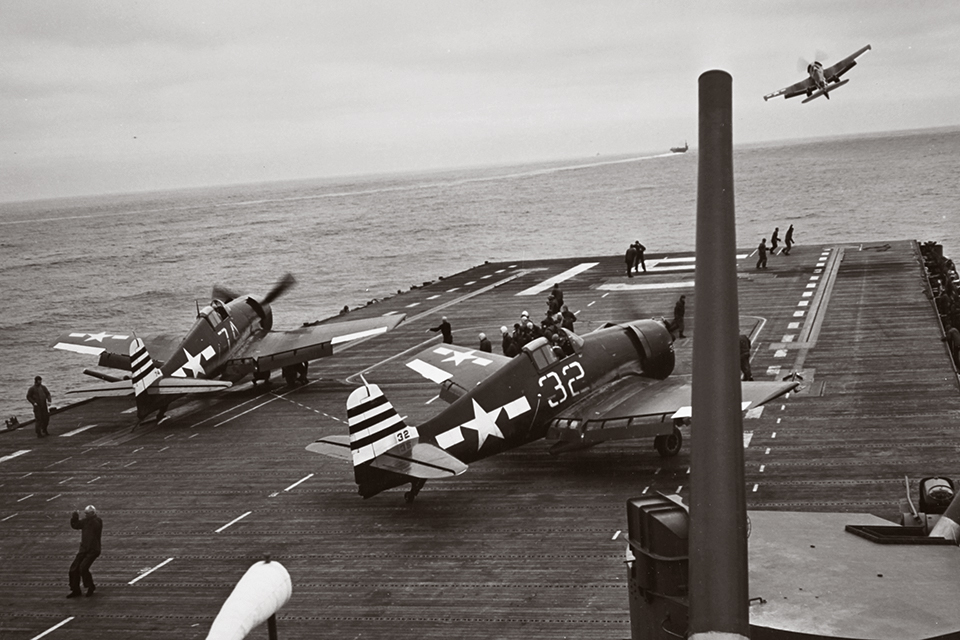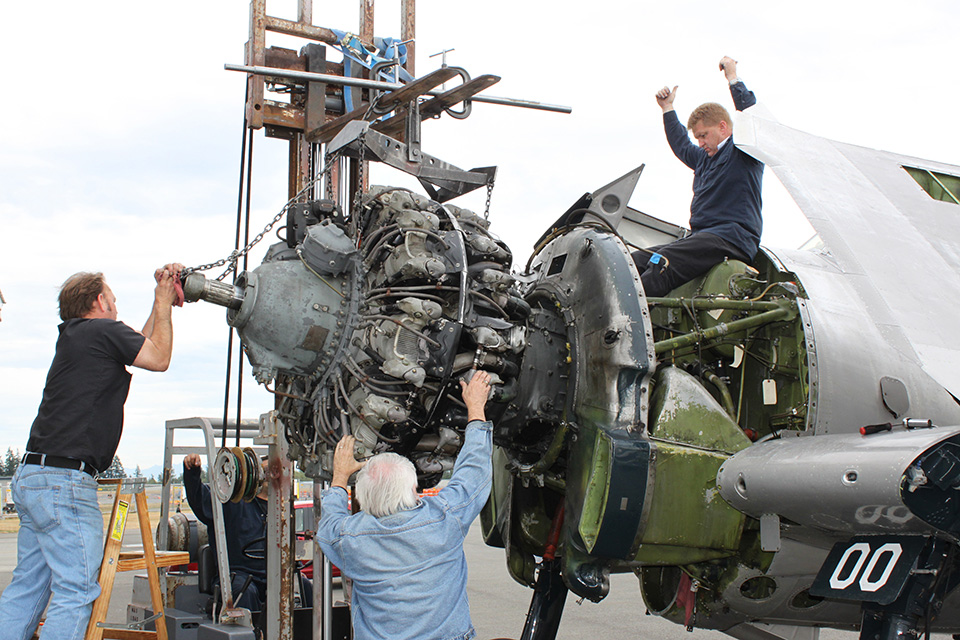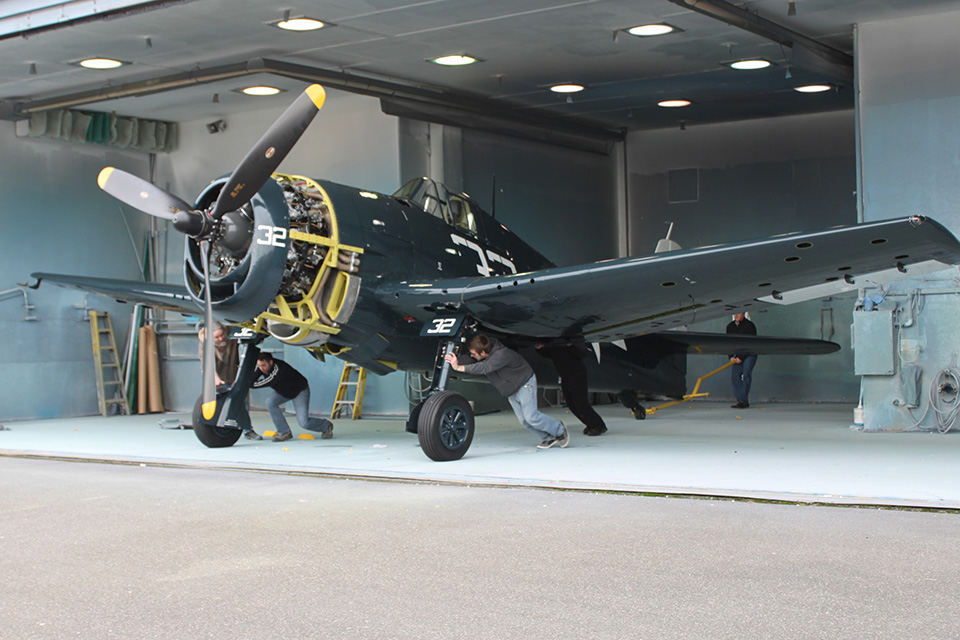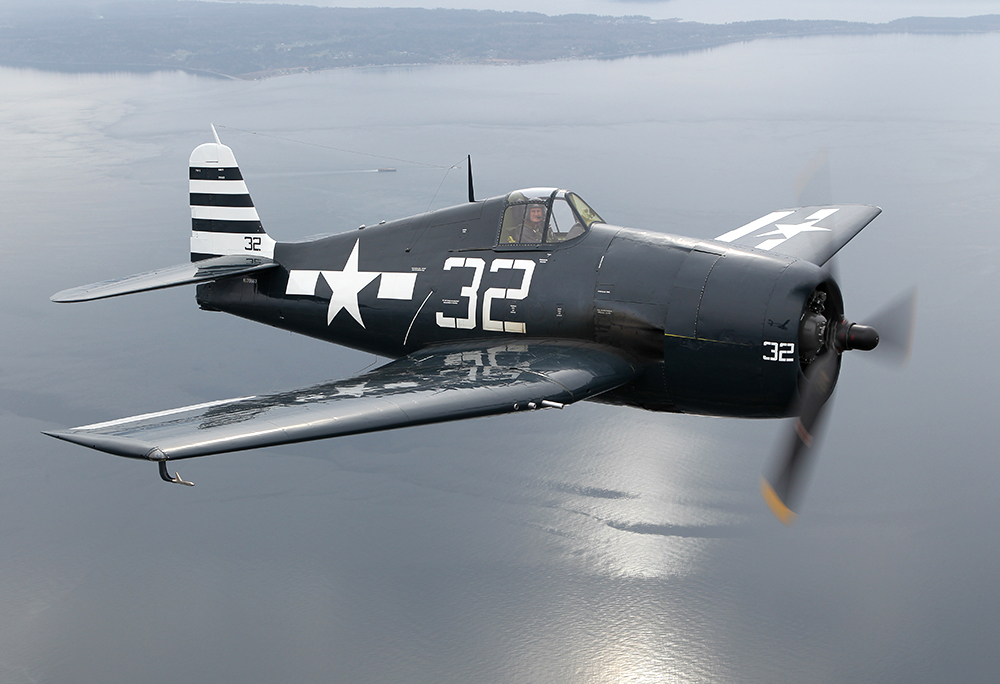In June 1942, while the Grumman F4F-4 Wildcat was taking the Mitsubishi A6M2 Zero’s measure at Midway, Grumman was completing a successor designed to wrest the sky from the nimble Japanese fighter once and for all. First flying on June 26, the F6F-3 Hellcat made its combat debut in August 1943. By the end of that year, it had established supremacy over the Zero, and would maintain it to the end of World War II.
Besides being tougher than the already rugged Wildcat, the F6F-3 boasted the greatest wing area of any single-seat American fighter. Its bulky airframe was yanked through the sky by a 2,000-hp Pratt & Whitney R-2800-10 Double Wasp radial engine with two-speed, two-stage supercharger, further boosted by water-injection in the R-2800-10W that powered the F6F-5. With a top speed of 386 mph, the Hellcat could not only outrun any Zero, it could even outmaneuver it, at least according to Japanese ace Saburo Sakai.

Though not the most elegant-looking airplane, the Hellcat has a record that speaks for itself—credited with 5,223 enemy planes destroyed and producing 303 aces, more than any other American fighter. Pilots loved its flying characteristics, as expressed by 23-victory ace Eugene Valencia after downing three Zeros over Truk on February 17, 1944: “Those Grummans are beautiful planes. If they could cook I’d marry one.”
Almost 70 years later, Cory Graff, military aviation curator for Paul Allen’s Flying Heritage Collection in Everett, Wash., feels the same way about the latest addition to the FHC’s hangar of flying veterans: “It’s a blue collar aircraft. After you fly it you fall in love with it. It’s an honest aircraft.”
Of the 26 surviving F6Fs, only four have been flying regularly—that is, until last year. “Our F6F flew for the first time on March 27, 2013,” said Graff. “Steve Hinton took it up—he’s our main guy for test flights. All went well; just a few tiny adjustments and away we go!” The F6F-5 had last flown in 1997, from Wichita, Kan., to England, for display at Doug Arnold’s Warbirds of Great Britain collection.
Originally built as an F6F-5N night fighter with wing-mounted radar, the FHC’s Hellcat was accepted on May 17, 1945, and shipped to Pearl Harbor in July. When the war ended a month later, the plane was returned Stateside to serve as a trainer before going into storage. In 1957 it was converted into a target drone and served at Naval Air Station Pensacola, Fla. “There are splatter marks on the tail sheet metal,” noted Graff, “and it has a replacement F6F-3 tail, complete with data plate, remodeled to -5 standard.” Its final assignment prior to retirement was at the Naval Air Weapons Station at China Lake. “According to Navy allowances, as of October 1961 there were two Hellcats in the Navy, including this one,” Graff said. “By November there were none.”

Upon retirement the F6F-5 was returned to Pensacola for display at the National Naval Aviation Museum, but there were no maintenance resources available, so it was traded back to Grumman Aircraft in Bethpage, Long Island, where factory employees restored it. It was then displayed at Pensacola from 1957 to 1972, and at Aerial Classics in Atlanta, Ga., from 1972 to 1984. From 1986 to 1991 it was held by the Patriot’s Point Museum in Mt. Pleasant, S.C., and then by Warbirds of Great Britain from August 1997 to February 2001, after which it returned to the U.S. and began undergoing restoration at Vulcan Warbirds Inc.
“The FHC’s F6F-5 never underwent a thorough restoration, so it is close to its original flying condition,” Graff noted. “The plane was basically intact. There were a few challenges. We had to go through the systems, making sure they work. In England, the bell crank on the elevators was gone, so they installed some plywood in the shape of the bellcrank in its place. We found an original and installed it. The engine was rebuilt by R-2800 Precision Engines, a local outfit, and the props sent out for restoration. The radio and instruments were changed from civilian to military standard.”
In one respect the restoration process involved a reduction in electrical equipment. “We could have retained the original radar system,” Graff explained, “but Paul Allen wanted a representative of an ‘everyman’ day fighter.” Therefore a lot of circuitry that accumulated within the plane in the course of its previous service as a night fighter and a drone was removed.
When the FHC received it, the F6F-5 was in a glossy Navy blue color scheme correct for 1945, but incongruously marked as the early F6F-3 in which Lt. Cmdr. James Flatley led Yorktown’s Air Group 5 in 1943. “We gave it a new paint job on Valentine’s Day 2013,” Graff said. “We decided we would strip off all the paint, and saw this as an opportunity to honor a local ace, Reuben Denoff, who flew from the carrier Randolph, with its G-symbol, a white tail with blue stripes. There were lots of photos of Randolph airplanes, including one overturned, which confirmed that the underside as well as the upper side of the aileron was white. We talked with Barrett Tillman about the proper Grumman stencil font, and even he said, ‘I have no idea, I’ll ask around.’ We applied a lot of stenciling, even for the ammo trays.”

Born in Chicago in 1914, Reuben Henry Denoff flew F4F-4s with VF-9 from the carrier Essex over North Africa in November 1942, and an F6F-3 with that same fighter squadron when he scored his first two victories off Rabaul on November 11, 1943. He was with fighter-bomber squadron VBF-12 aboard Randolph during the first carrier raid on the Japanese Home Islands on February 16, 1945, when he downed two Japanese fighters, followed by his fifth victory on April 22. On May 12, he took command of the squadron. Retiring from the Navy as a commander in 1961, he moved to Kennewick, Wash., and worked in the McDonnell Douglas Labs in Richland. Denoff died of cancer on January 5, 1988.
Attendees at the FHC’s Free Summer Fly Days can even see the Hellcat put through its paces alongside its old rival, in the form of the collection’s A6M3—powered, in the interests of reliability, by a Pratt & Whitney R-1830, “the most compact we had to fit in a legitimate Zero-type cowling,” Graff said. “We maintain a careful orchestration between the FAA and the tower, only putting them through the maneuvers we can get away with—belly passes, banana passes, tail chase. It’s a unique opportunity. We compare ourselves to a safari, not to a taxidermist’s shop. Here you can see, hear and smell the aircraft. Every time I hear the whistles, the high-pitched whine with that low engine sound…it’s kind of cool.” For more information and a full schedule of events, visit flyingheritage.com.
Originally published in the July 2014 issue of Aviation History. To subscribe, click here.





